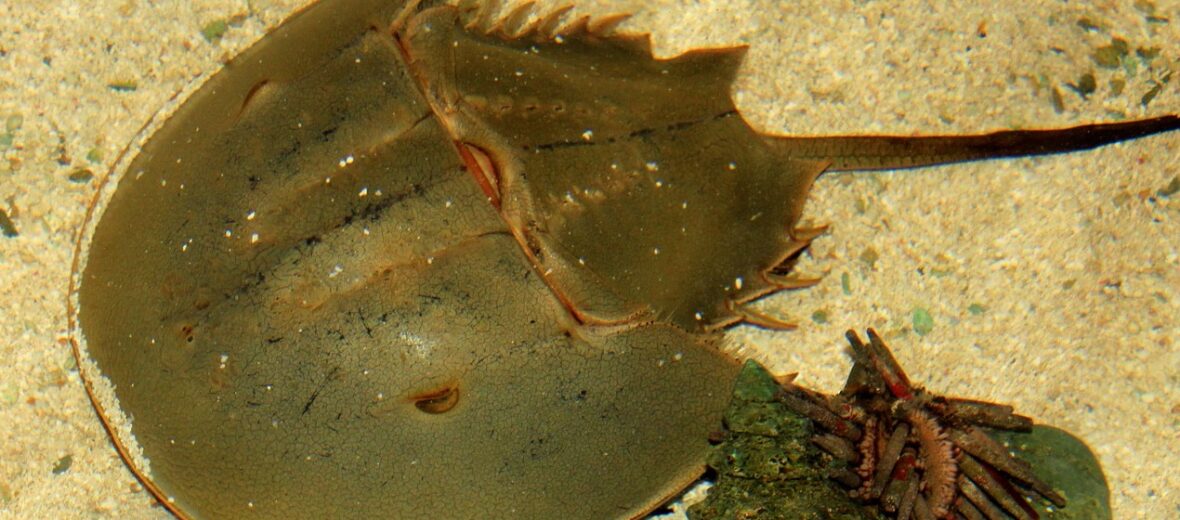
Surviving for around 450 million years, the horseshoe crab has changed little over the millions of years. Hence they are known as living fossils. They get their name from the shape of their carapace. Horseshoes are not true crabs, nor even crustaceans; although they are a subdivision of arthropods. These critters like shallow coastal waters with soft, muddy, or sandy bottoms. They typically spawn in intertidal zones during spring and summer high tides. Due to habitat destruction and over-harvesting, these bizarre critters are listed as anywhere from Vulnerable to Endangered and their populations are decreasing.
First the Stats…
Scientific name: Limulidae
Weight: Up to 10 lbs.
Length: Up to 2 feet
Lifespan: Up to 20 years
Now on to the Facts!
1.) They are more closely related to spiders and scorpions than to crabs. These critters have been placed into the chelicerate category, a subphylum that includes arachnids.
2.) Their spiked tail isn’t used for stinging. It is used as a rudder while swimming and to help right themselves, should they get flipped upside down.
3.) Horseshoe crabs eat aquatic worms, algae, carrion (dead animals), and their favorite: clams and mussels.
4.) Human blood uses iron-based hemoglobin to transport oxygen throughout our body. Horseshoe crabs rely on hemocyanin, which uses copper. Copper turns bluish when exposed to oxygen.
5.) Undersea sediment is dirty. Just a single gram of substrate can contain 1 billion bacteria. Living in this dirty environment can be dangerous. Especially when you lack white blood cells to fight infections. Instead, they have special cells called amebocytes that attack pathogens in the horseshoe crab’s body by closing them inside a slimy shield, and this helps stop infections.
But wait, there’s more on the horseshoe crab!
6.) With the discovery of how their blood reacts to bacteria, scientists have discovered that they can introduce a bit of horseshoe crab blood to a vaccine sample (for instance) and if the blood starts producing amebocytes then the vaccine isn’t ready to distribute yet.
7.) They are sexually dimorphic in that females are 20% – 30% larger than males.
Did you know…?
Horseshoe crabs have several pairs of eyes. 2 large compound eyes on the prosoma (the fused head and thorax) that can magnify sunlight up to 10 times. A pair of simple eyes on the front of the prosoma for sensing the ultraviolet light of the moon. And multiple eyespots under the prosoma, plus more on the underside of their tail.
8.) Females cling to the back of the male, and catches released sperm. The female is typically surrounded by several males at once.
9.) The female then digs a burrow in the sand or mud and releases the eggs; up to 120,000 at a time. With only 10 – 20 individuals ever reaching adulthood.
10.) Shorebirds tend to eat most of the eggs before they even hatch.
But wait, there’s still more on the horseshoe crab!
11.) Horseshoe crab blood sells for upwards of $15,000 per quart!
12.) Horseshoe crabs use what are called book gills to get oxygen from the water. The gill filaments are located in small flaps that look like pages of a book. If these primitive gills stay moist, horseshoe crabs can stay out of the water for up to 4 days! Stranded crabs during spawning will bury themselves in the sand or even fold themselves in half to conserve water until the tide comes in again.
13.) New Jersey and South Carolina currently prohibit any harvesting of horseshoe crabs, and Delaware limits harvesting to only males.
14.) Up to 30% of their blood is drained before returning them to the beach. Many fall ill as a result and die.
Now a Short Horseshoe Crab Video!
Also, check out the Critter Science YouTube channel. Videos added frequently!
Want to suggest a critter for me to write about? Let me know here.



